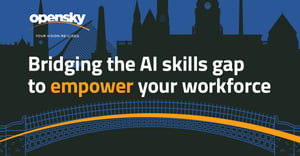Evaluating Enterprise AI Readiness
AI readiness is no longer a futuristic concept but a fundamental requirement for large enterprise organisations.
As a head of IT in an enterprise organisation, your role fundamentally drives initiatives that align with your organisation's strategic goals, enhancing operational efficiency, and fostering innovation. The journey towards AI integration is intricate, marked by unique business challenges and the need for a comprehensive strategy. This blog aims to provide you with a step-by-step direction on evaluating your AI readiness, ensuring your organisation is positioned for a successful digital transformation.
.png?width=724&height=724&name=AI%20Readiness%20Steps%20(2).png)
1. Understand Your Organisation’s Strategic Goals
The first step in evaluating your AI readiness is to have a clear understanding of your organisation's strategic goals. AI implementation should not be an end in itself but a means to support your organisation's vision and objectives. Whether it's improving customer experience, streamlining operations, or enabling new product innovations, defining these goals will help identify the AI solutions that align best with your needs.
2. Assess Your Data Infrastructure
❤️At the heart of AI is data. Your ability to leverage AI technologies depends significantly on the quality and accessibility of your data. Assess your current data infrastructure to identify gaps in data collection, storage, and management practices. Ensuring your data is clean, well-organised, and accessible is crucial for training AI models effectively. This assessment should also include considerations for data privacy and security, ensuring compliance with regulations and protecting sensitive information.
3. Evaluate your Technological Infrastructure
AI adoption requires a robust technological infrastructure that can support the computational demands of AI applications. This includes hardware, software, and networking resources. Evaluate your current IT infrastructure to determine if upgrades or enhancements are necessary. This might involve investing in cloud services, edge computing devices, or specialised AI processors. Additionally, assess the scalability of your infrastructure to accommodate future growth and the integration of new AI solutions.
4. Assess Talent & Skills
Implementing AI technologies requires a team with the right mix of skills. This includes not only data scientists and AI specialists but also project managers, business analysts, and IT professionals who understand how to integrate AI into existing systems and workflows. Evaluate your current team's capabilities and identify any skill gaps. Consider upskilling existing employees, hiring new talent, or partnering with external experts to fill these gaps.
5. Define your AI Strategy
With a clear understanding of your strategic goals, data and technological infrastructure, and talent capabilities, the next step is to define your AI strategy. This involves identifying specific AI use cases that align with your business objectives, estimating the potential ROI, and setting clear timelines and milestones for implementation. Your AI strategy should also include plans for ongoing monitoring and optimisation to ensure the AI solutions continue to deliver value as your business needs evolve.
6. Establish Governance and Ethical Guidelines
As AI technologies can have significant ethical and societal implications, establishing a governance framework is essential. This includes developing policies and guidelines around data usage, AI model transparency, and decision-making processes. Ensuring that your AI initiatives align with ethical standards and social responsibility is crucial for building trust among stakeholders and mitigating risks.
7. Pilot & Scale
Before full-scale implementation, pilot projects can provide valuable insights into the practical challenges and potential impacts of your AI initiatives. Choose pilot projects that are manageable in scope but representative of larger-scale implementations. Analyse the outcomes of these projects to refine your AI strategy, addressing any technical, operational, or ethical challenges that arise. Based on the successes and lessons learned from pilot projects, gradually scale your AI implementations, ensuring they are aligned with your strategic goals and operational capacities.
Conclusion
As an IT leader, you are more than familiar with the importance of fostering a culture that embraces innovation - a critical factor for sustaining AI readiness. Encourage experimentation, tolerate failure as a learning opportunity, and promote cross-functional collaboration. As AI technologies and applications evolve, staying informed about the latest trends and advancements will enable your organisation to adapt and thrive in the digital era.
In conclusion, evaluating your AI readiness is a multifaceted process that requires a strategic approach, aligned with your organisation's goals and challenges. By systematically assessing your data and technological infrastructures, talent capabilities, and establishing a clear AI strategy, you can ensure that your organisation is well-positioned for a successful digital transformation. Remember, the journey toward AI integration is ongoing, and fostering a culture of innovation and continuous learning will be your key to staying ahead in the dynamic landscape of digital technology.


